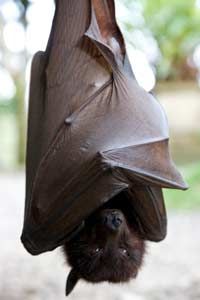Off the coast of Tanzania, nestled against Africa's eastern coast, sits the island of Pemba. While it's not a tourist hotspot, Pemba boasts dazzling shore lines, complete with coral reefs, sprawling mangroves and clove trees, which give the air a faintly spicy aroma. Perhaps more impressive than the pristine geography is the anatomy of one of Pemba's native residents.
The Pemba flying fox bat is one of the largest bat species in the world, with a wingspan stretching 5.5 feet (1.6 meters) across. Since the 1990s, conservationists have worked feverishly to preserve the dwindling population. The flying fox bat used to be a routine dish on Pemba dinner tables, and people hunted so aggressively that the International Union for the Conservation of Nature (IUCN) classified the bat as endangered in 1992.
Advertisement
Although the IUCN bumped the flying fox bat's conservation status from endangered up to vulnerable in 2008, it isn't uncommon to encounter bats on the menu in other African and Asian locales. According to Bat Conservation International, there are more than 1,100 species of bats around the globe, composing about one-fourth of all mammalian species. Moreover, the largest, meatiest varieties fly the skies in the Eastern hemisphere.
Bats on the Menu
Travelers in parts of China, Thailand, Guam and even Australia might run across bats in food markets and restaurants. Varieties of fruit bats, including the sizable flying fox bat, are the most popular to eat. When it comes time to cook them up, Pemba islanders usually roast their bats, and other cultures might toss bits of bat into soups and stir-fry. In 1976, Calvin W. Schwabe, defender of strange foods the world over, offered up a simple Samoan recipe for bat in his book "Unmentionable Cuisine." After skinning and disemboweling the bats, Schwabe recommended cutting up the meat and either baking or deep-frying it with salt, pepper and onions.
In "Extreme Cuisine," famed chef Anthony Bourdain cautions traveling gastronomes of a particularly pungent smell that wafts from simmering bat. But the actual flavor should be far more benign. As with many mystery meats, bat reportedly tastes a lot like chicken. To rustle up one's own batty entrée, Bourdain says to season it with some peppers, onions or garlic (not unlike a roasted chicken recipe) to mitigate that strong scent.
Fruit Bats and Emerging Diseases
Sampling local bat may not be a wise choice in light of recent medical developments. In Guam, officials linked flying fox bats to a form of dementia called ALS/PDC; among the native Chamorro people, the incidence rate was 50 to 100 times higher than sample populations. And while fruit bats' insect and fruit diet may seem harmless enough, they may also harbor some unwanted and downright dangerous diseases. Medical experts have traced strains of SARS, Ebola and other emerging diseases back to them. Fruit bats in Gabon, for instance, have been culprits for carrying Marburg and Ebola virus. Officials are mostly concerned about bats leaving behind pathogens after nipping a piece of fruit or passing them along to another animal through tainted saliva, as in the case of Nipah virus in Malaysia. Nevertheless, if savvy travelers are offered morsels of deep-fried bat, they ought to choose health over cultural etiquette and politely decline the exotic snack.
Advertisement
